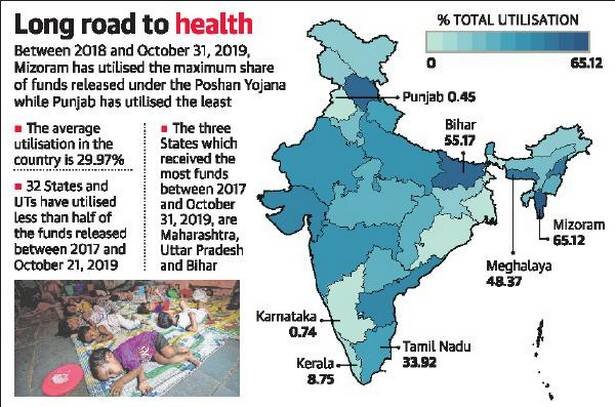Mere 30% of Poshan Abhiyaan Funds Used | 30 Dec 2019
Why in News
Only 30% of the funds released under the Poshan Abhiyaan have been utilised by the State governments and the Union Territories since it was launched in 2018.
- Until October 31, 2019, only 29.97% of the funds granted were used.
Key Points
- Poshan Abhiyaan:
- It is the centre’s flagship programme which aims at improving nutritional outcomes among pregnant women, lactating mothers and children by reducing the level of stunting, underweight, anaemia and low birth weight by 2022.
- It was launched to benefit more than 10 crore people with a total budget of ₹9,046.17 crore for three years.
- 50% of the total budget comes from the World Bank or other multilateral development banks and the rest of the 50% is through Centre’s budgetary support.
- Centre’s budgetary support is further divided into 60:40 between the Centre and the States, 90:10 for the north-eastern region and the Himalayan States and 100% for the Union Territories without legislature.
- Best Five Performers- Mizoram (65.12%) > Lakshadweep (61.08%) > Bihar (55.17%) > Himachal Pradesh (53.29%) > Meghalaya (48.37%).
- Worst Five Performers- Punjab (0.45%) < Karnataka (0.74%) < Kerala (8.75%) < Jharkhand (13.94%) < Assam (23.01%).
- The programme was conceptualised to be implemented in phases so the utilisation will increase over the years. Few services showed a slow start and are now pickling up like the Integrated Child Development Services-Common Application Software (ICDS-CAS).
- The Ministry of Health and Welfare released the Comprehensive National Nutrition Survey (CNNS) in October which showed that 35% of children under the age of 5 are stunted and in this age group, 17% are wasted (low weight for height) and 33% underweight (low weight for age).
Integrated Child Development Services
- The scheme provides specific interventions targeted towards the vulnerable groups include children below 6 years and women.
- It is being implemented by the Ministry of Women and Child Development.
- It provides a package of six services namely supplementary nutrition, pre-school non-formal education, nutrition & health education, immunization, health check-up and referral services.
- Common Application Software is intended to use technology for furthering of the objectives of the scheme.

